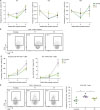INTRODUCTION
MATERIALS AND METHODS
Animals
Design of aquatic exercise with tumor animal model
Flow cytometry analysis
Detection of soluble γc receptor
Statistical analysis
RESULTS
Aquatic exercise at TT suppresses tumor growth
 | Figure 1Control of tumor growth by aquatic exercise at TT. (A) Time schedule for aquatic exercise. Tumor-bearing mice were treated with 30 min of aquatic exercise at different temperatures (TT and BT) per day for 6 days or were housed as control (n=6 per group). Tumor growth was monitored every few days. (B) BT of mice. Mouse BT was determined by measurement of rectal temperature at the indicated day after tumor challenge (left), and measured before and after the aquatic exercise (right). (C) Serum sγc level was measured at the indicated weeks in aquatic exercising or housing tumor-bearing mice. Data are representative of three mice per group. (D) Tumor growth curve of the aquatic exercise group and housing group. Tumor-bearing mice started to exercise 3 days after the tumor challenge. Tumor volume was measured every few days. Tumor growth is representative of two independent experiments with each six mice per group. (E) Tumor weight was measured at the end of the experiment. The summary graph is representative of 2 independent experiments with each six mice per group. Error bars represent mean and SEM.NS, not significant.
**p<0.01, ***p<0.001.
|
Aquatic exercise at TT increases the number of effector cells
 | Figure 2An increase of immune cellularity by aquatic exercise at TT. Tumor bearing mice had aquatic exercise (n=9 per group) and 3 mice were randomly sacrificed every wk after aquatic exercise. Immune cells were individually isolated from LN, dLN, and spleen of mice that underwent aquatic exercise. (A) The number of LN (left), dLN (middle), and spleen cells (right) in housing, TT and BT groups. These immune cells were isolated from exercising tumor-bearing mice for 3 wk. Data are representative for two independent experiments with three mice per group (B) The number of immune cells in the spleen after 3 wk. The bar graphs are representative for two independent experiments with three mice per group. (C) The number of indicated subsets among total spleen CD4+ (left) and CD8+ (right) T cells at 3 weeks. Each number in the table represents the average number of the cells (×106, p<0.05 for TT vs BT; mean and SEM).NS, not significant.
*p<0.05, ***p<0.001.
|
Aquatic exercise at TT enhances IFNγ production of CD8+ T cells
 | Figure 3Enhancement of cytokine production by CD8+ T cells at TT. Tumor bearing mice had aquatic exercise (n=9 per group) and 3 mice were randomly sacrificed every wk after aquatic exercise. Splenocytes were isolated from housing and aquatic exercise (at TT and BT) groups of mice for 3 weeks and were stimulated for 4 h with PMA and ionomycin to assess for T cell functional activity. (A) Frequency of IFNγ-, IL-4- and IL-17-producing CD4+ T cells. Data are representative for 2 independent experiments with three mice per group. (B and C) IFNγ expression of CD8+ T cells in housing and aquatic exercise (at TT and BT) groups. The IFNγ profile is representative for 2 independent experiments with three mice per group. (C) Frequency (left) and number (right) of IFNγ+CD8+ T cells 3 wk after aquatic exercise. (D) dLN cells were isolated from housing and aquatic exercise (at BT and TT) groups of mice at 3 weeks. These cells were stimulated for 4 h with PMA and ionomycin and assessed for IFNγ expression by intracellular staining. The profile of IFNγ+CD8+ T cells in dLN (left), and a summary of frequencies (right). The IFNγ profile is representative for 2 independent experiments with three mice per group. Error bars represent mean and SEM.
*p<0.05, **p<0.01, ***p<0.001.
|




 PDF
PDF Citation
Citation Print
Print



 XML Download
XML Download